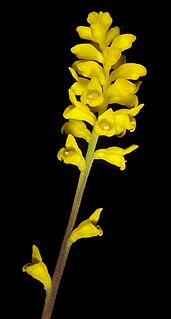
Banksia drummondii, commonly known as Drummond's dryandra, is a species of shrub that is endemic to Western Australia. It has pinnatifid to pinnatisect leaves, heads of up to one hundred cream-coloured, red and yellow flowers and glabrous fruit.

Synaphea is a genus of small shrubs and is endemic to Western Australia. Synapheas have variably shaped leaves but consistently yellow flowers with an unusual pollination mechanism.

Synaphea spinulosa is a species of small shrub in the flowering plant family Proteaceae. It is endemic to Western Australia. Together with Acacia truncata, it was the first Australian endemic to be scientifically described and named, and the specimen upon which that description is based is the oldest extant specimen of an Australian plant, and very likely among the first Australian plant specimens ever collected.

Isopogon drummondii is a small shrub of the family Proteaceae and is endemic to the southwest of Western Australia. It was first formally described in 1843 by Henri Antoine Jacques in Annales de Flore et de Pomone from an unpublished description by Hügel.

Petrophile drummondii is a species of flowering plant in the family Proteaceae and is endemic to southwestern Western Australia. It is a shrub with rigid, pinnate leaves with needle-shaped, sharply-pointed pinnae, and spherical heads of hairy, fragrant, yellow flowers.
Synaphea aephynsa is a shrub endemic to Western Australia.
Synaphea bifurcata is a shrub endemic to Western Australia.
Synaphea canaliculata is a shrub endemic to Western Australia.

Synaphea cuneata is a shrub endemic to Western Australia.
Synaphea damopsis is a shrub endemic to Western Australia.
Synaphea diabolica is a shrub endemic to Western Australia.

Synaphea grandis is a shrub in the Proteaceae family, endemic to Western Australia.
Synaphea hians is a shrub endemic to Western Australia.
Synaphea media is a shrub endemic to Western Australia.
Synaphea obtusata is a shrub endemic to Western Australia.
Synaphea pinnata, commonly known as Helena synaphea, is a shrub endemic to Western Australia.
Synaphea platyphylla is a shrub endemic to Western Australia.
Synaphea sparsiflora is a shrub endemic to Western Australia.
Synaphea stenoloba is a shrub endemic to Western Australia.
Synaphea xela is a shrub endemic to Western Australia.






